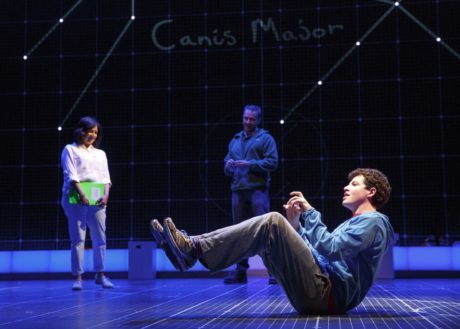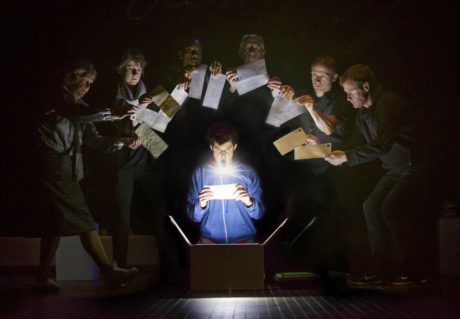Now and then there comes a production of a play that is so spectacularly original it confounds one’s every expectation of what can be achieved in theater. The story—a marvel in itself—could not be told more mind-blowingly. There’s no way the play could work as well any other way.

That’s what I remember thinking about a year ago when I left New York’s Ethel Barrymore Theater having first experienced The Curious Incident of the Dog in the Night-Time. This profound and penetrating play—based on a novel written in the voice of a brainiac 15-year-old boy named Christopher—had been realized so perfectly that every rave I had read about its dazzling production was bested by what I saw and heard for myself.
So naturally I was eager to find out whether the show on tour would be as good. Its breakthrough wonders of stagecraft could not be easy to truck about. That dizzyingly animated set, that blazing light plot, that sonic boom-box sound track—all so central to the sensory and cerebral stimulation of the show—they’d have to replicate all that tech-citement on the road, right?
Well, that’s what they did alright, and the whole gosh-wow shebang can now be experienced in the Opera House at The Kennedy Center.
Purists might note a few inconsequential road-show accommodations: There’s no staircase that on Broadway protruded astonishingly from the upstage wall so that Christopher could bound up it; the stage floor doesn’t suddenly gape open so that Christopher can leap onto train tracks. But for all practical perceptual purposes, The Curious Incident is as thrillingly hallucinatory as before.
And then, on top of the theatrical extravaganza, there’s the extraordinary emotional inner life of the drama itself. Its main character, Christopher, cannot bear to be touched. Apparently on the autism spectrum, Christopher inhabits not his body so much as his very literal-minded intelligence, which is capable of prodigious mathematical calculations but incapable of inferring meaning from commonplace metaphors and idioms. And right off the bat (to use an expression that would confuse Christopher), the play has done something without any precedent in theater that I can recall: In taking as its point of view the intellectually hyper-engaged but emotionally alienated Christopher, The Curious Incident introduces us to a wholly original cognitive and emotional relationship to a character and story line.

The “curious incident” that incites the plot is a dead dog, a pitchfork stuck into it, that lies centerstage before the play begins. The dog belonged to a neighbor of Christopher’s, and he sets out, Sherlock Holmes–like, to find the killer. His path of detective work leads him to learn not only that but much more, especially about his mother and father and how his family has been torn apart in ways that he had no clue. It’s a drama of discovery that would deeply distress any 15-year-old, but because the story is told through the naive/wise eyes of a child whose mental default is logical analysis, we get to witness the powerful narrative without incessant sentimentality yet with epic ethical clarity.
The Curious Incident of the Dog in the Night-Time is an unparalleled coup de théâtre. Don’t even think about missing it.
Running Time: Approximately 2 hours and 30 minutes, with one 15-minute intermission.
The Curious Incident of the Dog in the Night-Time plays through October 23, 2016 at The Kennedy Center’s Opera House – 2700 F Street, NW, in Washington, DC. For tickets, call (202) 467-4600, or purchase them online.
LINK:
Review: ‘The Curious Incident of the Dog in the Night-Time’ at The Kennedy Center by Gina Jun.
RATING:





“Apparently on the autism spectrum” is almost exactly the correct way to describe the disingenuous way National Theater handle Christopher Boone’s disability, although it could do with more detail.
In 2009 Mark Haddon admitted that “curious incident is not a book about asperger’s”, admitting that “i know very little about the subject”, justifying his utter fecklessness with the glib line “imagination always trumps research.” Ros Hayes of the National Theatre argues that since Boone never specifies his diagnosis behind using the phrase “behavioural problems”, the audience can interpret the character however they please. This position allows the company to profit from the public’s interest in autism without taking responsibility for how they represent the condition.
Many autistics despise both the book and the play of Curious Incident, as Boone embodies some of the most stigmatising myths about the condition – he is violent, incapable of empathy and his condition causes his parents to seperate. These are the stereotypes the fuel school bullying, employment discrimination and darker forms of abuse.
If you wish to read a more elaborate version of this post, you can find it at https://goo.gl/GQSRF2.
I must respectfully disagree with the comments of CuriousOnScreen when he describes as “stigmatizing myths” the facts that children on the autism spectrum can be violent, incapable of empathy, and their condition can cause parents to separate. Autism is a SPECTRUM and on that spectrum various degrees of these three truths exist. I have watched the heroic efforts of my brother and sister-in-law as they raised my now twenty-five-year-old autistic niece. My brother resisted any kind of institutionalization of my niece until a violent episode occurred just a few years ago in which my niece injured and endangered my sister-in-law. That episode which followed other episodes of explosive violence of a lesser degree forced my brother to face the fact that he and his wife could no longer safely keep their daughter with them full time. Though my niece is now under special care in an institution during the week, my brother and sister-in-law want my niece to know she is still their beloved daughter; they take her on special outings every weekend or bring her home to spend quiet time with them. My autistic niece is on many anti-psychotic drugs to help keep her from being violent not only to others, but to herself. In many instances she has scratched her face or banged her head against the wall when frustrated. Of course, this took a toll on my brother’s marriage through the years with a near separation–though he has managed to remain married. With the amount of stress both parents were coping with, neither was to blame for the strains in their marriage. The violence is not constant and my niece remains able to be helpful, kind, and loving as well as being easily overstimulated, overanxious or overwhelmed.
I would also argue that I did not view the Christopher of this play as being portrayed as incapable of empathy. I am not sure what you were referring to in this regard. Christopher asks one of the characters in the play if murdering a dog is a “minor crime” as has been suggested. That he is told it is a “minor” crime is shocking, but one can see that Christopher, who has great empathy for the dog, does not agree with this assessment. This play’s Christopher also demonstrated empathy for both parents despite the fact that each committed such egregious parental offenses.
I have worked in a middle school with a large number of autistic children. The school attempted to both offer extra support for these kids and also mainstream them into regular education classes. Some of these children cried and fell apart emotionally when they were trying to pass the mandated tests of the “No Child Left Behind” era. Some of these children had tantrums and screamed during class in a way that was fully disruptive to the other classroom students and the classroom teacher. Some of the more highly functioning children who were diagnosed with Asperger’s sat alone and lonely at lunch tables; the school made a real effort in a “buddy program” to help with that isolation and to educate all the kids in regards to bullying any other children. But challenges were abundant.
I found the play, The Curious Incident of the Dog in the Nighttime, to be a most positive affirmation of what is best about autistic kids at all ends of the spectrum. Christopher, to my mind, is portrayed not only as intelligent, but as curious, strong, courageous, assertive, certainly truthful, and very human. The physical ticks, shutting-down reactions to too much stimuli, phenomenal memory and intelligence, and the absolute literal perception of language were true to the core; I have observed them all in my niece. I thought the play was definitely not to be missed and Adam Langdon’s portrayal was nothing short of genius.
John – Based on a cousin’s glowing recommendation (after seeing the NYC production), I bought an expensive ticket to see this show at the KC. An interesting play and story, but a “mesmerizing”
“absolute must see”…not in my book. Two friends who also came left with the same feeling, one liking the show better than me and the other disliking it, having slept through parts. Both of them had read the book and liked it…I had not read it.